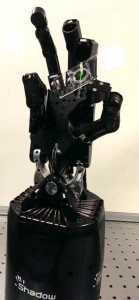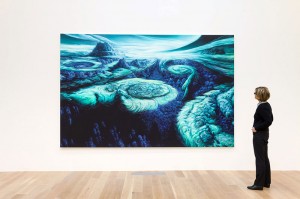To be clear, the Star Trek-type ‘tricorder’ referred to in the heading is, in fact, a hand-held spectrometer and the research from Purdue University and the Indian Institute of Technology Madras represents a developmental leap forward, not a new product. From a March 26, 2014 news item on Azonano,
Nanotechnology is advancing tools likened to Star Trek’s “tricorder” that perform on-the-spot chemical analysis for a range of applications including medical testing, explosives detection and food safety.
Researchers found that when paper used to collect a sample was coated with carbon nanotubes, the voltage required was 1,000 times reduced, the signal was sharpened and the equipment was able to capture far more delicate molecules.
Dexter Johnson in his March 26, 2014 posting (Nanoclast blog on the IEEE [Institute of Electrical and Electronics Engineers] website) provides some background information about the race to miniaturize spectrometers (Note: A link has been removed),
Recent research has been relying on nanomaterials to build smaller spectrometers. Late last year, a group at the Technische Universität Dresden and the Fraunhofer Institute in Germany developed a novel, miniature spectrometer, based on metallic nanowires, that was small enough to fit into a mobile phone.
Dexter goes on to provide a summary about this latest research, which I strongly recommend reading, especially if you don’t have the patience to read the rest of the news release. The March 25, 2014 Purdue University news release by Elizabeth K. Gardner, which originated the news item, provides insight from the researchers,
“This is a big step in our efforts to create miniature, handheld mass spectrometers for the field,” said R. Graham Cooks, Purdue’s Henry B. Hass Distinguished Professor of Chemistry. “The dramatic decrease in power required means a reduction in battery size and cost to perform the experiments. The entire system is becoming lighter and cheaper, which brings it that much closer to being viable for easy, widespread use.”
Cooks and Thalappil Pradeep, a professor of chemistry at the Indian Institute of Technology Madras, Chennai, led the research.
“Taking science to the people is what is most important,” Pradeep said. “Mass spectrometry is a fantastic tool, but it is not yet on every physician’s table or in the pocket of agricultural inspectors and security guards. Great techniques have been developed, but we need to hone them into tools that are affordable, can be efficiently manufactured and easily used.”
The news release goes on to describe the research,
The National Science Foundation-funded study used an analysis technique developed by Cooks and his colleagues called PaperSpray™ ionization. The technique relies on a sample obtained by wiping an object or placing a drop of liquid on paper wet with a solvent to capture residues from the object’s surface. A small triangle is then cut from the paper and placed on a special attachment of the mass spectrometer where voltage is applied. The voltage creates an electric field that turns the mixture of solvent and residues into fine droplets containing ionized molecules that pop off and are vacuumed into the mass spectrometer for analysis. The mass spectrometer then identifies the sample’s ionized molecules by their mass.
The technique depends on a strong electric field and the nanotubes act like tiny antennas that create a strong electric field from a very small voltage. One volt over a few nanometers creates an electric field equivalent to 10 million volts over a centimeter, Pradeep said.
“The trick was to isolate these tiny, nanoscale antennae and keep them from bundling together because individual nanotubes must project out of the paper,” he said. “The carbon nanotubes work well and can be dispersed in water and applied on suitable substrates.”
The Nano Mission of the Government of India supported the research at the Indian Institute of Technology Madras and graduate students Rahul Narayanan and Depanjan Sarkar performed the experiments.
In addition to reducing the size of the battery required and energy cost to run the tests, the new technique also simplified the analysis by nearly eliminating background noise, Cooks said.
“Under these conditions, the analysis is nearly noise free and a sharp, clear signal of the sample is delivered,” he said. “We don’t know why this is – why background molecules that surround us in the air or from within the equipment aren’t being ionized and entering into the analysis. It’s a puzzling, but pleasant surprise.”
The reduced voltage required also makes the method gentler than the standard PaperSpray™ ionization techniques.
“It is a very soft method,” Cooks said. “Fragile molecules and complexes are able to hold together here when they otherwise wouldn’t. This could lead to other potential applications.”
The team plans to investigate the mechanisms behind the reduction in background noise and potential applications of the gentle method, but the most promising aspect of the new technique is its potential to miniaturize the mass spectrometry system, Cooks said.
Here’s a link to and a citation for the paper,
Molecular Ionization from Carbon Nanotube Paper by Rahul Narayanan, Depanjan Sarkar, Prof. R. Graham Cooks, and Prof. Thalappil Pradeep. Angewandte Chemie International Edition Article first published online: 18 MAR 2014 DOI: 10.1002/anie.201311053
© 2014 WILEY-VCH Verlag GmbH & Co. KGaA, Weinheim
This paper is behind a paywall.
![Courtesy: NNI [downloaded from http://www.nano.gov/node/1128]](http://www.frogheart.ca/wp-content/uploads/2014/03/2015_nni_funding-300x207.jpg)


